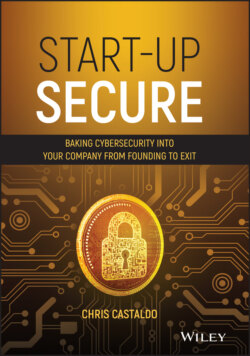Читать книгу Start-Up Secure - Chris Castaldo - Страница 13
CHAPTER ONE Minimum Security Investment for Maximum Risk Reduction
ОглавлениеAn ounce of prevention is worth a pound of cure.
– Benjamin Franklin
NO ONE PLANS ON THEIR START-UP not making it past a year of business, so you should also plan for your investment and planning in cybersecurity to scale into the future. While selecting the bare minimum may seem and feel counterintuitive and is certainly against the opinion of many cybersecurity professionals, it will ensure the continuation of the business.
Just as the heart is the first organ to receive oxygenated blood from the lungs, the continued operation of your start-up should be the number one priority. Security must enable the business to operate and find a balance as a requirement for the business. Cybersecurity is now a priority business function and no longer solely an IT issue.
When discussing cybersecurity many thoughts come to mind, all culminating with three important categories: people, processes, and technology. As a start-up, you won't always have the option of deploying all three. And even many mature organizations do not. This is why when we discuss cybersecurity we must also discuss risk and managing risk. The goal of your cybersecurity strategy should be to reduce, mitigate, and accept risk. No two organizations are the same, even within the same industry vertical. The risk of not being Payment Card Industry Data Security Standard (PCI DSS) certified could mean the loss of revenue for one organization and absolutely nothing to another.
Cybersecurity must be included in your enterprise risk management along with things like compliance, financial reporting, business continuity, etc. It should be all-encompassing and avoid siloing each off into its own risk management vertical. Cybersecurity is a huge part of all of these pieces. All of the following compliance and regulatory requirements require a varying level of cybersecurity practice and maturity (and we'll review these in more detail in Chapter 10):
Payment Card Industry (PCI)
Sarbanes–Oxley Act (SOX)
North American Electric Reliability Corporation (NERC)
Health Insurance Portability and Accountability Act (HIPAA)
HITRUST
The credibility of your business is important to protect. This is why you seek professional advice from lawyers and accountants. A start-up with three founders and without capital cannot afford to hire a full-time world-class lawyer (also referred to as general counsel) or accountant, let alone a chief finance officer (CFO). There are, however, many services that offer those capabilities that can meet a start-up's needs at every phase of the scaling life cycle. You shouldn't feel concerned by the fact that you can't afford a full-time chief information security officer (CISO) or world-class cybersecurity team; alternatives exist that are appropriate for your start-up life cycle stage.
Regardless of the type of business you are starting or industry you plan to sell into, cybersecurity can scale with your idea. From a next-generation weapons system for the military or taking credit card transactions with some new smart device, security can be adequately included. Protecting your intellectual property (IP) and business doesn't require you to have decades of cybersecurity experience; it only requires a willingness and drive to learn. Not everything I discuss will be easy or “point and click,” but I will show you the steps along the way to scale your security, along with your business, from seed funding to initial public offering (IPO) or whatever your exit strategy might be.
There is a common phrase when describing old-school cybersecurity approaches where it is like an M&M – crunchy outside and soft inside. When cybersecurity is applied with a hardened perimeter, the thing you want to protect most may actually be more vulnerable from the false sense of security that is created.
When approaching cybersecurity for your new start-up you should focus on the following:
The data or capabilities you want to protect
The systems with that data or capabilities you want to protect
The people with access to those systems you want to protect
